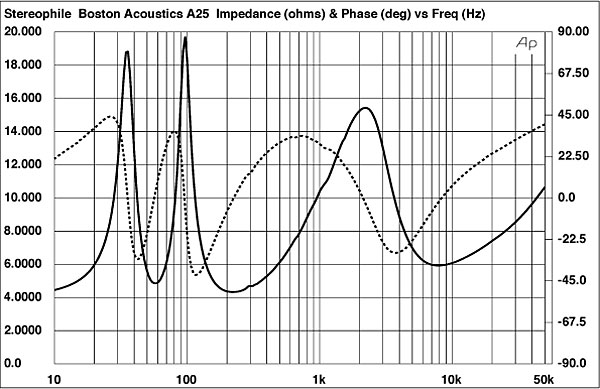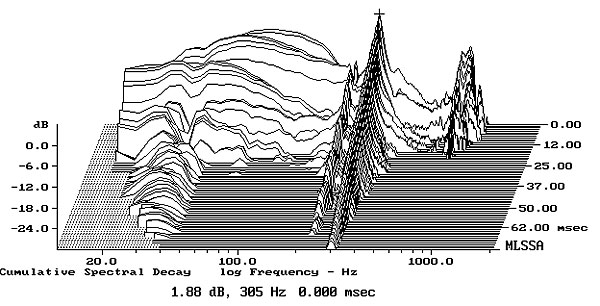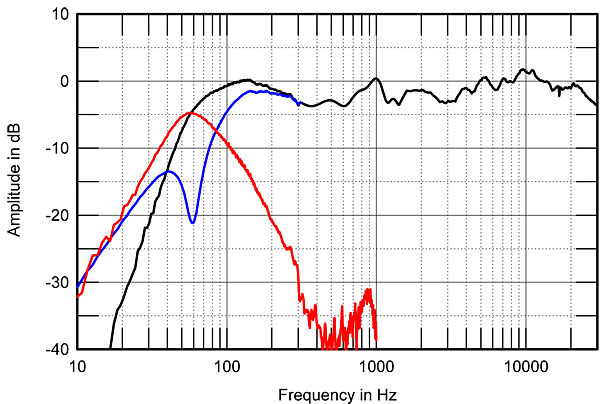| Columns Retired Columns & Blogs |
How would you compare these speakers to the Wharfedale Diamond 10.1 speakers? Which do you prefer?
The A 25's B-weighted sensitivity on its tweeter axis was 87.5dB/2.83V/m, which was higher than I expected for such a small loudspeaker. The electrical impedance (fig.1) remained at or above 6 ohms for much of the audioband, and though it dropped to 4.3 ohms just above 200Hz, the A 25 will be a relatively easy load for the partnering amplifier to drive. There is a suspicious-looking wrinkle in the impedance traces at 300Hz; investigation of the enclosure's vibrational behavior with a plastic-tape accelerometer revealed a major resonant mode at this frequency that was present on all surfaces (fig.2). This might add a touch of midrange congestion at high playback levels.


The low-frequency saddle centered on 60Hz in the impedance-magnitude trace suggests that this is the tuning frequency of the rear-facing reflex port, which is 1" in diameter. This is confirmed by the fact that the notch in the woofer's nearfield output (fig.3, blue trace) occurs at the same frequency. The port's output (red trace) peaks between 40 and 90Hz and rolls off smoothly above that region without any pipe resonant modes evident. The complex sum of the nearfield woofer and port responses (black trace below 300Hz) peaks in the upper bass, but this will be entirely the result of the nearfield measurement technique; the Boston speaker is flat down to 90Hz or so, with its low-frequency output dropping by 6dB at the port tuning frequency. This is a textbook ported-woofer alignment.

Higher in frequency in fig.3, the A 25's farfield response on its tweeter axis is impressively flat for such an inexpensive speaker, though a small peak is visible at 1kHz. At low levels, this will accentuate recorded detail; at high levels, it will add a touch of hardness. It might also lead to a slightly nasal character, though SM didn't mention any such coloration. Nor did Stephen say whether he listened to the A 25s with their grilles in place or not. The response in fig.3 was taken without the grille; with the grille, the A 25 lost a little energy in the mid-treble, while the top octave became peaky rather than flat (not shown).
For an inexpensive speaker, the Boston's lateral dispersion is impressively wide and even below 8kHz or so (fig.4). Above that frequency, the speaker becomes quite directional, which in typically sized rooms will balance the slight rising trend in the top two audio octaves. In the vertical plane (fig.5), a suckout develops in the crossover region for listening axes above the cabinet top. The A 25 needs to be used with stands tall enough to place the listener's ears on or just below the tweeter axis.


In the time domain, the Boston's step response on its tweeter axis (fig.6) indicates that both drive-units are connected in positive acoustic polarity, and that the decay of the tweeter's step smoothly blends into the start of the woofer's, which correlates with the excellent integration of their outputs on this axis in fig.3. A slight wobble in the decay of the woofer step ties in with some delayed energy at the frequency of the on-axis response peak in the cumulative spectral-decay plot (fig.7). Other than that, this plot is impressively clean.


I can't help admiring what the Boston Acoustics design team has achieved with this inexpensive speaker. I'm not surprised that SM liked it as much as he did.—John Atkinson

How would you compare these speakers to the Wharfedale Diamond 10.1 speakers? Which do you prefer?

I can't answer your question properly because I didn't have the speakers on hand to compare side-by-side, but the Wharfedales struck me as having a more nuanced sound with lots of delicacy, grace, and inner detail, while the Boston Acoustics were more about creating a wide, stable soundstage, while providing impact, clarity, and presence. I'm not sure which speaker I miss more, but I do miss them both.

It sounds like you really enjoy these speakers. It is always good to get a first hand account of how speakers work and whether or not they are worth the price, things get too confusing otherwise.
Speakers for en ligne casino or listening room are a dime a dozen so when we see someone describe in detail the quality of a certain set we will remember it.